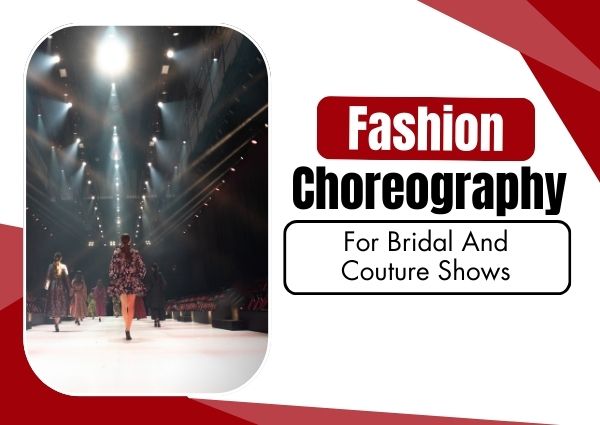At Babla Kathuria, we specialize in choreographing luxury experiences where models don’t just walk the runway—they glide, emote, and enchant. The unique nature of bridal and couture fashion makes choreography both a challenge and an artistic opportunity.
Understanding the Heart of Bridal and Couture Collections
Bridal and couture outfits are not like prêt-à-porter or streetwear. They are heavier, more ornate, and often carry symbolic or emotional value. Particularly, bridal gowns have their roots in customs, traditions, and desires, whilst couture items are the result of many hours of creativity and artistry.
As choreographers, we must respect the weight and worth of the garment. Our movements are not designed for speed or shock value, but for elevation. A walk must give time for the embroidery to catch the light, for the drape to flow, for the audience to soak in the detail. The choreography should let the garment breathe, while still holding the audience in awe.
Tempo, Music, and the Mood of Romance
Unlike high-energy fashion shows, bridal and couture runways demand a different tempo—slow, graceful, and cinematic. The music must align with this mood. Orchestral melodies, soft piano, or ambient strings work beautifully to create a romantic and regal atmosphere.
We always start at Babla Kathuria with the designer’s inspiration. Is the collection inspired by royal Indian weddings? Parisian haute couture? Vintage Victorian gowns? The music and choreography must reflect the emotion behind the design. Every beat should match the model’s pace, and every step must carry the weight of elegance.
We also work with live musicians or custom soundtracks when possible to add intimacy and immersion to the show. The walk becomes not just a movement—but a moment.
Showstoppers: Crafting the Signature Bridal Entry
In most bridal or couture shows, the highlight is the showstopper—often a celebrity or lead model wearing the collection’s centerpiece look. This entry is never rushed. It is choreographed with precision, poise, and power.
In order to let the gown sparkle and attract everyone’s attention, the showstopper walk frequently starts with a lengthy spotlight entry. The model may pause in the middle of the ramp, execute a slow spin, or even interact briefly with the audience or photographer pit. Sometimes, designers request special cultural elements like a symbolic “phera” walk or a hand gesture tied to heritage.
We at Babla Kathuria design this moment with absolute care. It must reflect the soul of the collection, and often becomes the most shared, photographed, and remembered part of the entire show.
Choreographing for Heavier Outfits and Accessories
One of the biggest challenges in bridal and couture shows is the physicality of the garments. Although they are beautiful, long veils, capes, can-can skirts, layered lehengas, intricate embroidery, or beaded trains require choreography that balances comfort, stability, and elegance.
We often modify standard walks to reduce speed, minimize sudden turns, and create long gliding sequences. We also train models specifically for garment handling techniques—how to lift a train subtly, how to turn without tripping on a flare, or how to hold a dupatta or veil while maintaining posture.
In many shows, we coordinate with designers during fittings to adjust choreography based on real-time movement feedback. Choreography in bridal and couture shows must honor the garment’s needs, not fight them.
Lighting, Stage Design, and Luxury Visuals
Bridal and couture shows are immersive experiences. Choreography doesn’t stop at movement—it extends to stage layout, lighting cues, and set design. Models’ stance and gait can be altered by a floral tunnel, a palace-like background, or a floating ramp over water.
Lighting is especially important. Spotlights must be soft yet flattering. Color and intensity shifts have to correspond with choreography cues. A veil drop or twirl must be timed with a lighting accent for maximum visual drama.
At Babla Kathuria, we collaborate with production teams and designers from the very beginning to orchestrate an atmosphere, not just a sequence. Every step taken under those lights should feel like a scene from a royal dream.
Cultural Integration and Storytelling
Many bridal shows are deeply tied to cultural heritage—be it Indian, Middle Eastern, European, or fusion styles. Choreography must include cultural sensitivity and celebration. We may incorporate subtle nods to traditional gestures, classical poses, or even symbolic walking styles.
For instance, in Indian bridal shows, choreography might begin with a slow mandap-inspired walk, include a dupatta reveal, or close with the designer joining the bride for a symbolic “finale step.” These touches don’t just elevate the experience—they make it emotionally resonant for the audience.
At Babla Kathuria, we choreograph shows that honor the designer’s craftsmanship, uplift the model’s presence, and mesmerize the audience. Whether it’s a royal bridal walk or a couture fantasy brought to life, we believe that choreography is the final stitch that completes the garment’s journey to the stage.
Because in the world of bridal and couture, it’s not just about how the model walks—it’s about how the moment lives on in every heart that watches.

